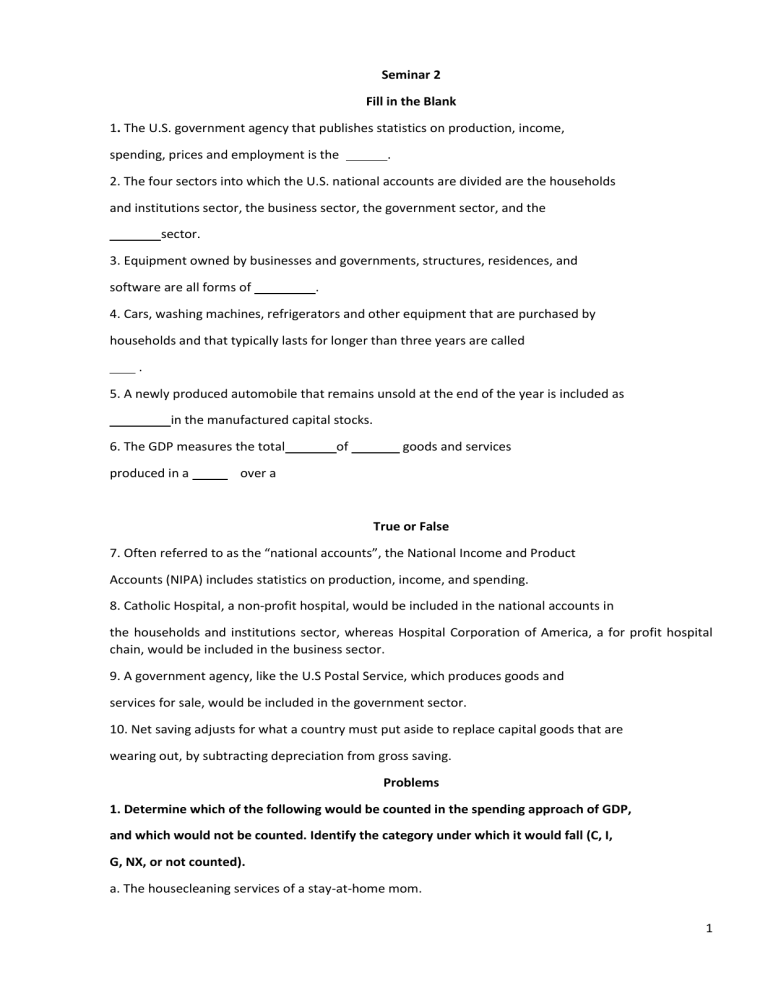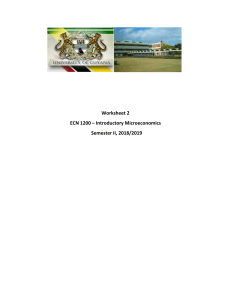
Seminar 2 Fill in the Blank 1. The U.S. government agency that publishes statistics on production, income, spending, prices and employment is the . 2. The four sectors into which the U.S. national accounts are divided are the households and institutions sector, the business sector, the government sector, and the sector. 3. Equipment owned by businesses and governments, structures, residences, and software are all forms of . 4. Cars, washing machines, refrigerators and other equipment that are purchased by households and that typically lasts for longer than three years are called . 5. A newly produced automobile that remains unsold at the end of the year is included as in the manufactured capital stocks. 6. The GDP measures the total produced in a of goods and services over a True or False 7. Often referred to as the “national accounts”, the National Income and Product Accounts (NIPA) includes statistics on production, income, and spending. 8. Catholic Hospital, a non-profit hospital, would be included in the national accounts in the households and institutions sector, whereas Hospital Corporation of America, a for profit hospital chain, would be included in the business sector. 9. A government agency, like the U.S Postal Service, which produces goods and services for sale, would be included in the government sector. 10. Net saving adjusts for what a country must put aside to replace capital goods that are wearing out, by subtracting depreciation from gross saving. Problems 1. Determine which of the following would be counted in the spending approach of GDP, and which would not be counted. Identify the category under which it would fall (C, I, G, NX, or not counted). a. The housecleaning services of a stay-at-home mom. 1 b. The housecleaning services of the “Merry Maids” company. c. The babysitting services of a babysitter whose earnings are kept “off the books” and not reported to the tax authorities. d. A brand new house built and sold this year. e. A new car made by Ford in the U.S., and sold to a household in the U.S. f. A new car made by Ford in the U.S, and sold in Mexico. g. Sale of a 2012 used Ford car. h. 3 shares of Ford Motor Company stock i. A new car made by Ford in the U.S. but not sold by the end of the year. j. A new car added to the fleet of taxis of Mr. Taxi Company. k. A new bridge to accommodate all the new and used cars and taxis on the road. 2. Use the following table to answer the next question: a. Assuming that no intermediate inputs are used other than the ones named, what is the value added at each stage of production – Stage 1-5? b. Using the value added approach, what is the total contribution to the GDP of this chain of production? c. Using the expenditure approach, what is total contribution to the GDP of this good? Explain why the number you got in part c is (or is not) the same as that from part b. 2 3. The small economy of the United States of Sustainability has only three companies: a bicycle manufacturer, a wind energy producer, and an organic cheese company. The only costs these companies have are the cost of their inputs and wages. Assume there are no rents, no depreciation, and no net income payments from the foreign sector. Assume all the output is sold to consumers as final goods. The companies’ profits = Value of output (total revenues) – total costs. a. Calculate the GDP of the United States of Sustainability using the income approach. b. Calculate the GDP of the United States of Sustainability using the spending approach. c. Calculate the GDP of the United States of Sustainability using the value-added approach. 4. Assume a simple economy produces only two goods, corn and wheat. In the first year 100 bushels of corn are produced, and sold for $3 a bushel. Also in the first year, 50 bushels of wheat are produced, and sold for $5 a bushel. In the second year, 110 bushels of corn are produced, and sold for $3.50, while 55 bushels of wheat are produced, and sold for $5.50. a. Calculate the nominal GDP in year 1 and 2. b. Using the constant-dollar approach, calculate the real GDP in year 1 and 2. Take year 1 as the base year. c. Calculate the growth in real GDP between years 1 and 2 (with year 1 as the base year). d. Calculate a constant weight price index for the second year, using the first year as the base. e. What is the growth rate of prices (inflation rate) from the first to the second year? 3 Self Test 3. Which of the following non-financial capital stocks are included in GDP? a. Natural capital, manufactured capital, human capital, and social capital. b. Natural capital, and manufactured capital. c. Human capital, and social capital. d. Manufactured capital only. e. None of the above. 4. Which of the following is not included as a fixed asset in the national accounts? a. Office equipment b. Factories and office buildings c. Houses and apartment buildings d. Computer software e. Inventories 5. Which of the following would not be included in the measure of U.S. GDP in the current year? a. A new machine, made in the U.S. and purchased that year for the Ford motor company assembly line. b. A Ford automobile newly produced that year in the U.S. c. A Ford automobile, newly produced that year in the U.S. but unsold and sitting in a warehouse. d. Three shares of Ford motor company stock purchased that year in the U.S. e. The steel produced and sold that year to make a new Ford automobile. 6. Which of the following would not be counted as an addition in the measure of the U.S. GDP in the current year? a. A car produced and sold in the U.S. by the Japanese-owned Toyota company. b. A car produced in the U.S. by the U.S.-owned Ford motor company, and sold in Japan. 4 c. Restaurant meals in the U.S. sold to Canadian tourists visiting the U.S. d. Restaurant meals in Canada sold to U.S. tourists visiting Canada. e. A car produced in the U.S. by the Japanese-owned Toyota company, and sold in Canada. 8. Assume the government is trying to measure the value of production of a non-profit institution providing non-market services in a community. The cost of office supplies used per year is $5,000. The payroll expenses are $150,000 per year. The institution owns its own building, which if it rented out would cost $12,000 per year. The value of services production that would be imputed for this non-profit institution would be a. $12,000 b. $150,000 c. $155,000 d. at least $167,000 e. It is impossible to calculate the value of services produced by this non-profit institution if its services are not sold are not sold on the market. 11. In order to measure GDP by the spending approach, to highlight the portions that are considered to be consumption vs. investment, which identity should be used? a. GDP = Household and institution spending + Business spending + Net foreign sector spending + Government spending b. GDP = Personal consumption + Private investment + Net exports + Government consumption c. GDP = Personal consumption + Private investment + Net exports + Government consumption + Government investment d. a and c e. none of the above. 12. Which of the following would be included in the income approach to measure GDP? a. Wages and benefits, profits, rents b. Wages and benefits, profits, investment spending c. Wages and benefits, rents, investment spending, consumption spending 5 d. The value added in production e. None of the above. 13. Which of the following would not be included in the U.S. GDP, as measured by the income approach? a. The wages earned by workers at a German company located in the U.S. b. The profits earned by a German company from its plant located in the U.S. c. The profits earned by a U.S. company from its plant located in China. d. The rents earned by a U.S. landlord with rental properties. e. The interest payments earned by a U.S. bank from its loans. 14. Which of the following is a price index? a. GPI b. HDI c. PPI d. REI e. None of the above 15. The price index that is most frequently reported in the news is the a. Consumer price index (CPI) b. Producer price index (PPI) c. Earnings index d. The GDP deflator e. Export price index 16. The GDP deflator is measured as: a. Nominal GDP divided by real GDP b. Real GDP divided by nominal GDP c. Real GDP multiplied by nominal GDP d. The rate of change of nominal GDP e. The rate of change of real GDP 6 7





